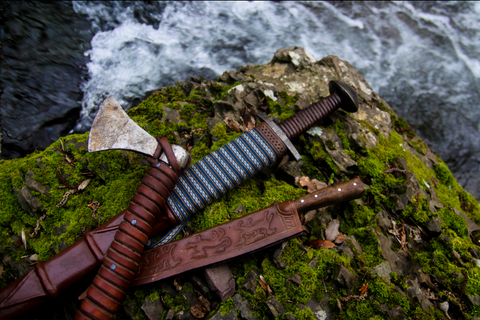
Asatru, Asatru faith, Everyday life of Vikings, life of Vikings, nordic, Norse, Norse age, Norse Culture, Norse explorer, Norse history, Norse Vikings, norse warrior, Odinism, viking, Viking Age, Viking culture, Viking daily life, Viking fan, Viking history, Viking lovers, Viking seafarers, vikings, Vikings history -
Everyday life of Vikings
The Vikings, a community of Scandinavian seafarers active from the late 8th to the early 11th centuries, gained renown for their maritime raids, trade expeditions, and explorations. At the heart of Viking existence were their self-sufficient homesteads, known as "hofs." Constructed from wood with thatched roofs, these dwellings typically comprised a single room featuring a central hearth for cooking and warmth. More affluent Vikings might have separate rooms for distinct purposes like sleeping, working, and food storage.
Agriculturally adept, Vikings cultivated their crops, raised livestock, and supplemented their diet through hunting and fishing. Their culinary preferences embraced a variety of meats, including beef, pork, and game, along with an assortment of vegetables like beans, peas, and turnips. Bread and porridge from grains like oats and barley were dietary staples.
Viking society assigned specific roles, with men engaged in farming, hunting, and construction, while women handled cooking, cleaning, and crafting household items. Some individuals pursued specialized professions such as blacksmithing, carpentry, or tanning.
Social stratification in Viking communities comprised three classes: nobles, freemen, and thralls (slaves). Nobles, the most affluent and influential, possessed extensive land and trade control. Freemen, independent farmers or craftsmen, owned their land and worked for themselves. Thralls were slaves working under the nobles or freemen.
Chieftains, typically powerful nobles, governed Viking society, advised by a council of respected elders. Renowned for their warrior ethos, many Vikings served in chieftains' armies, with the elite berserkers gaining a reputation for unstoppable ferocity in battle.

Viking families were tightly-knit, centered around the household. The father held the position of the household head, and family members were expected to follow his directives. Family loyalty was highly esteemed, often reflected in the tradition of naming children after grandparents or ancestors.
Viking spirituality centered around a pantheon of gods led by Odin, the god of war, death, and wisdom. Believers in an afterlife, Vikings practiced burial traditions accordingly. Notable figures received elaborate ship burials, sometimes including possessions and slaves, while common Vikings were cremated, and their ashes were interred in urns within graves.
In essence, Viking daily life revolved around self-sustaining homesteads, diverse occupations, and a class-based society led by chieftains. Family ties were paramount, and their renowned warrior culture and spiritual beliefs shaped their burial practices.
